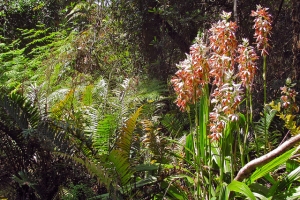20 OCTOBER 2014 Myora Springs on North Stradbroke Island is a tranquil site of environmental and cultural significance. It has a flowing freshwater spring that supports a unique ecosystem. Surrounded by eucalypt forest and fringed by mangroves, the pools of surface water are perfectly clear. 

Photos: S Graham
North Stradbroke Island is home to 18 species of land mammals including wallabies, kangaroos, echidnas, koalas and bandicoots. The springs are an important habitat for many of these, including the vulnerable Water Mouse (Xeromys myoides). The Water Mouse has silky, water repellent fur and is specialised for coastal marine and estuarine environments. It is also known as the False Water Rat and Yirrkoo. Read more about it here. The endangered Lesser Swamp Orchid (Phaius australis) [below] is also found at Myora Springs. Since European settlement, 95% of the original populations of the Lesser Swamp Orchid in North-east NSW and South-east Queensland have become extinct. It faces several threats (read more here) – on North Stradbroke Island these are mainly bushfires, habitat loss (e.g. from sand mining) and competition from invasive plant species (e.g. Lantana camara). 
Photo: Kieran Kinney (https://www.flickr.com/photos/anpc/8740261100/)
Myora Springs is of cultural significance to the Quandamooka people, the traditional owners of the island. It served as an important meeting place, and was a source of a variety of foods, especially shellfish. Today large middens are still visible along the banks.
Sand mining has taken place on North Stradbroke Island for more than 60 years. Mining leases have now been extended until 2035 and the Quandamooka people argue that they were not consulted on this matter. To learn more about the Quandamooka people and how they are challenging the Queensland Government in the High Court, listen to the ABC News radio program the via the tweet below.
Quandamooka people of Stradbroke Island to contest sandmining lease in court http://t.co/eVczh65FFV @amworldtodaypm
— Simon (@ephemeralise) October 22, 2014
Featured image photo: S Graham